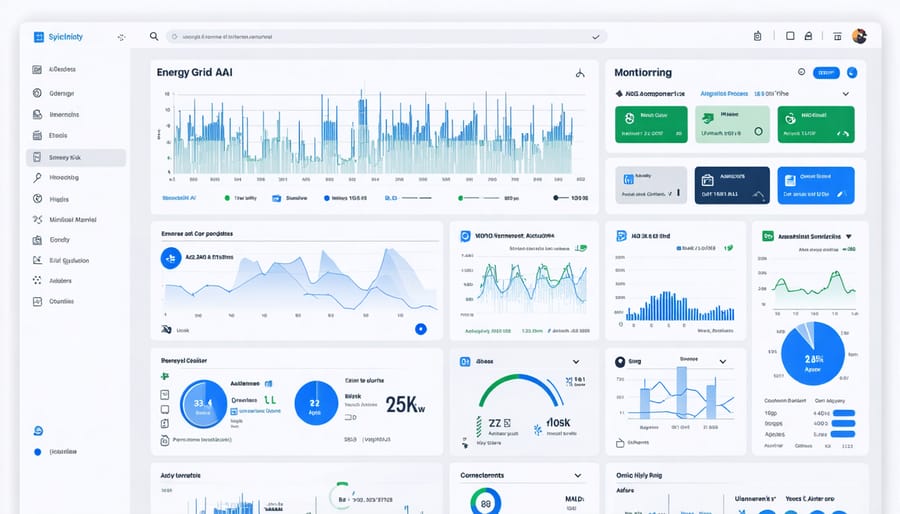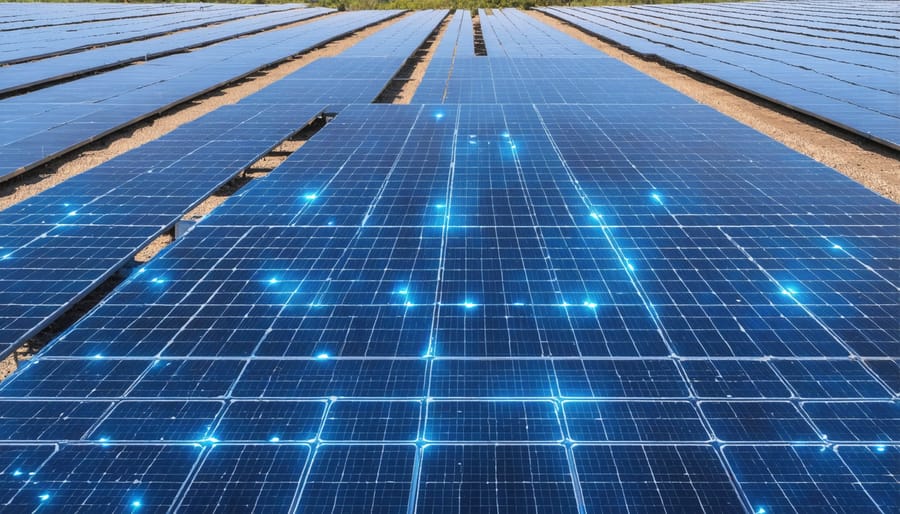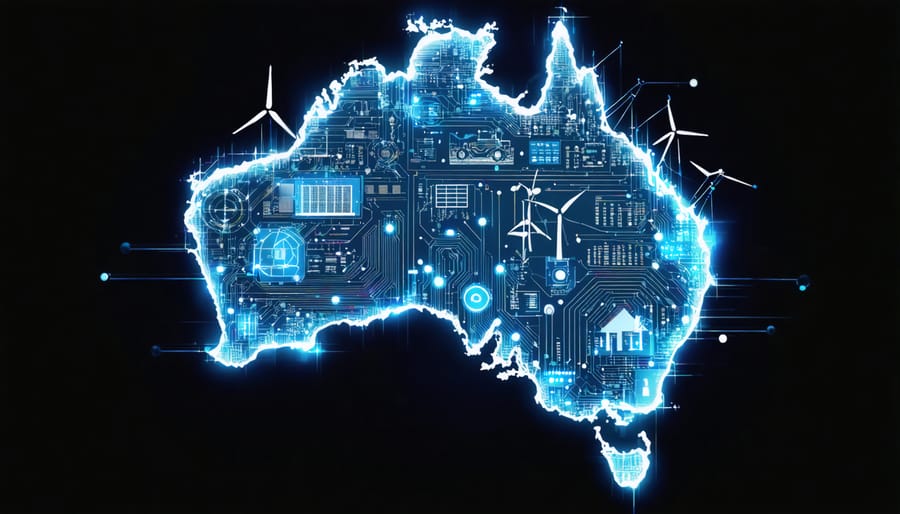Artificial Intelligence is revolutionizing Australia’s energy landscape, transforming how we generate, distribute, and consume power across the continent. From Perth’s solar farms to Sydney’s smart grids, AI-driven systems are already delivering unprecedented efficiency gains of up to 30% while slashing operational costs and carbon emissions.
At the intersection of machine learning and energy management, innovative solutions are emerging that can predict equipment failures before they occur, optimize renewable energy integration, and balance grid loads in real-time. These technological advances aren’t just theoretical – they’re actively reshaping our energy future, with Australian utilities reporting maintenance cost reductions of 25% through AI-powered predictive analytics.
The impact extends beyond just operational improvements. AI is enabling the transition to renewable energy by solving complex challenges like intermittency and storage optimization. Smart algorithms are helping wind farms in South Australia increase their power output by up to 15% while reducing wear and tear on equipment. In Queensland, machine learning models are optimizing battery storage systems, ensuring reliable power supply even during peak demand periods.
This convergence of AI and energy technologies represents more than just an efficiency upgrade – it’s a fundamental shift in how we approach energy management, promising a more sustainable and resilient energy future for Australia.
How AI is Transforming Energy System Maintenance
Real-time Monitoring and Data Analysis
In today’s energy landscape, AI-powered monitoring systems are revolutionising how we detect and prevent equipment failures across Australia’s power infrastructure. These sophisticated networks employ thousands of sensors strategically placed throughout power plants, wind farms, and solar installations, continuously collecting real-time data on everything from temperature fluctuations to vibration patterns.
What makes this system truly remarkable is its ability to process massive amounts of data instantly. Advanced AI algorithms analyse these readings, comparing them against historical patterns to identify potential issues before they become critical. For instance, at the Hornsdale Power Reserve in South Australia, this technology has helped maintain the world’s largest lithium-ion battery with unprecedented efficiency.
The real magic happens in the predictive capabilities. When a turbine bearing shows subtle changes in its vibration pattern or a solar inverter’s performance slightly dips, the AI system flags these anomalies immediately. This early warning system gives maintenance teams the crucial head start they need, often preventing costly breakdowns and ensuring continuous power supply to communities.
These smart systems are proving particularly valuable in remote locations, where physical inspections can be challenging and costly. By enabling remote monitoring and automated alerts, they’re helping energy providers maintain reliable service while significantly reducing maintenance costs.

Machine Learning for Pattern Recognition
In the ever-evolving landscape of energy management, machine learning algorithms are revolutionising how we maintain and optimise our power infrastructure. Like a vigilant guardian, these AI systems continuously monitor equipment performance, analysing thousands of data points to detect subtle changes that might signal potential issues.
Think of it as having a highly skilled technician who never sleeps, keeping watch over every turbine, solar panel, and transformer in the network. By processing real-time sensor data, AI can identify patterns that would be impossible for human operators to spot, such as minute variations in vibration patterns or slight changes in operating temperatures.
In Australia’s renewable energy facilities, this predictive maintenance approach has already proven its worth. Wind farms across South Australia are using AI to anticipate blade wear and gearbox issues before they cause shutdowns, while solar installations in Queensland employ smart algorithms to detect panel degradation and optimize cleaning schedules.
The result? Maintenance costs have dropped significantly, and system reliability has improved dramatically. These systems are helping energy providers transition from reactive to proactive maintenance, ensuring more stable power supply for communities while reducing operational costs.
Practical Applications in Australia’s Energy Sector
Solar Farm Optimization
In the sun-drenched landscapes of Australia, artificial intelligence is revolutionizing how we manage and optimize solar farms. Through advanced machine learning algorithms and real-time monitoring systems, AI transforms solar panel efficiency optimization into a precise science, ensuring maximum energy generation from every ray of sunshine.
Modern solar farms employ AI-powered drones that conduct regular aerial inspections, capturing thermal imagery and detailed photographs to identify potential issues before they impact performance. These smart systems can detect everything from dust accumulation and microscopic cracks to faulty wiring, allowing maintenance teams to address problems proactively rather than reactively.
Weather prediction algorithms analyze local meteorological data to adjust panel positioning throughout the day, maximizing exposure to sunlight while protecting equipment during adverse conditions. This dynamic response system has shown to increase energy yield by up to 20% compared to traditional fixed-position arrays.
AI systems also excel at pattern recognition, identifying optimal cleaning schedules based on local environmental conditions. In dusty outback locations, these systems can determine precisely when panels need cleaning, balancing the cost of maintenance against potential energy losses from dirty surfaces.
Perhaps most impressively, machine learning algorithms can predict component failure before it occurs, scheduling maintenance during low-production periods to minimize disruption to power generation. This predictive maintenance approach has significantly reduced downtime and maintenance costs while extending the lifespan of solar infrastructure.
For solar farm operators, this means more reliable power generation, reduced operational costs, and better return on investment. For communities, it translates to more stable renewable energy supply and accelerated progress toward Australia’s clean energy goals.

Wind Turbine Maintenance
In the vast expanses of Australia’s wind farms, artificial intelligence is revolutionising how we maintain and operate wind turbines. By harnessing the power of machine learning algorithms, wind farm operators can now predict potential failures before they occur, dramatically reducing downtime and maintenance costs.
These AI systems continuously monitor thousands of data points from each turbine, including vibration patterns, temperature readings, and wind speeds. Like a skilled mechanic who can diagnose an engine problem just by listening, AI algorithms detect subtle changes in turbine performance that might signal upcoming issues.
For instance, at the Hornsdale Wind Farm in South Australia, AI-powered predictive maintenance has helped reduce unplanned downtime by up to 30%. The system analyses patterns in blade stress, gearbox wear, and bearing temperatures, allowing maintenance teams to schedule repairs during low-wind periods, maximising energy generation during optimal conditions.
The real magic happens in the AI’s ability to learn from experience. Each maintenance event feeds back into the system, making predictions more accurate over time. This smart approach has proven particularly valuable in Australia’s challenging climate, where extreme weather conditions can put additional stress on turbine components.
Beyond just predicting failures, AI systems are now optimising maintenance schedules across entire wind farms. They consider factors like weather forecasts, spare parts availability, and crew schedules to suggest the most efficient maintenance plans. This holistic approach ensures that wind farms operate at peak performance while minimising operational costs.
For wind farm operators, this technology translates into significant cost savings and improved reliability. More importantly, it helps ensure that renewable energy sources can consistently deliver clean power to Australian homes and businesses, supporting our transition to a more sustainable energy future.
Environmental and Economic Benefits
Reducing Carbon Footprint
Predictive maintenance powered by AI is revolutionising how we manage energy systems, leading to significant reductions in carbon emissions. By analysing real-time data from sensors and equipment, AI algorithms can detect potential failures before they occur, ensuring optimal performance and energy efficiency.
In Queensland, a major power station implemented AI-driven predictive maintenance and reduced its carbon emissions by 15% in the first year alone. The system monitors turbine performance, cooling systems, and power distribution networks, automatically adjusting operations for maximum efficiency while preventing energy-wasting breakdowns.
The impact extends beyond just preventing failures. AI systems continuously learn from operational data, suggesting optimal maintenance schedules and identifying energy-intensive components that need upgrading. For instance, Melbourne’s smart grid network uses predictive maintenance to reduce transmission losses by 8%, equivalent to taking 2,000 cars off the road annually.
These smart systems also help integrate renewable energy sources more effectively. When AI predicts maintenance needs for solar panels or wind turbines, it ensures these clean energy sources operate at peak efficiency. One South Australian wind farm increased its energy output by 12% simply by optimising maintenance schedules based on AI predictions.
For businesses looking to reduce their carbon footprint, predictive maintenance offers a practical solution that delivers both environmental and economic benefits. The technology not only prevents wasteful energy consumption but also extends equipment life, reducing the environmental impact of manufacturing replacement parts.
Cost Savings and ROI
When it comes to the bottom line, AI-powered maintenance systems in the energy sector are delivering remarkable financial returns. Australian energy companies implementing these smart solutions typically see a 15-25% reduction in maintenance costs within the first year alone. For instance, a major power plant in Queensland reported annual savings of $2.8 million after implementing AI predictive maintenance, primarily through preventing unexpected equipment failures and optimizing maintenance schedules.
The return on investment (ROI) becomes evident through multiple channels. First, by predicting equipment failures before they occur, companies avoid costly emergency repairs and unplanned downtime. A single prevented turbine failure can save upwards of $500,000 in repair costs and lost production. Second, AI systems extend equipment lifespan by ensuring optimal maintenance timing, reducing the frequency of major replacements and upgrades.
Energy providers are also seeing significant savings in labor costs, with AI-driven scheduling reducing unnecessary maintenance visits by up to 30%. The technology’s ability to monitor equipment performance in real-time means maintenance teams can work more efficiently, focusing their efforts where they’re needed most.
Moreover, these systems help companies optimize their spare parts inventory. By accurately predicting when components will need replacement, organizations can reduce warehouse costs while ensuring critical parts are available when needed. Some facilities report inventory carrying cost reductions of up to 20% after implementing AI maintenance systems.

Implementation Strategies for Energy Providers
Getting Started with AI Maintenance
Implementing AI-driven maintenance solutions doesn’t have to be overwhelming. By following proven AI adoption strategies, organizations can seamlessly integrate these smart systems into their existing operations. Start by conducting a thorough assessment of your current maintenance processes and identifying key pain points that AI could address.
Begin with a pilot program focusing on a single critical asset or system. This approach allows you to demonstrate value while minimizing risk. Install the necessary sensors and monitoring equipment to collect real-time data, ensuring they’re properly calibrated and connected to your network infrastructure.
Next, establish clear baseline measurements for system performance and maintenance costs. This data will be crucial for measuring the success of your AI implementation. Work with your team to develop specific maintenance protocols based on AI insights, and provide comprehensive training to maintenance staff.
Create a feedback loop between your maintenance team and AI system developers to continuously refine and improve the solution. Regular review sessions help identify areas for optimization and ensure the system meets your specific needs.
Remember to start small and scale gradually. Many Australian energy companies have found success by implementing AI maintenance solutions in phases, allowing teams to adapt and systems to be fine-tuned before expanding to broader applications. This measured approach helps ensure long-term success and maximum return on investment.
Overcoming Common Challenges
While AI technology offers tremendous potential for the energy sector, organisations often face several hurdles during implementation. The good news is that these challenges can be effectively managed with the right approach and mindset.
Data quality and availability often present the first major obstacle. Many Australian energy facilities operate with legacy systems that weren’t designed for modern data collection. The solution lies in gradual sensor deployment and establishing robust data management protocols before scaling up AI implementations.
Integration with existing infrastructure can also prove challenging. Success stories from companies like AGL Energy show that starting with pilot projects in specific areas, such as predictive maintenance for wind turbines, allows for smoother transitions and valuable learning experiences.
Cost concerns frequently arise, particularly for smaller operators. However, many organisations have found success by starting small and reinvesting the savings from initial AI implementations into larger projects. Government grants and industry partnerships can also help offset initial investments.
Workforce adaptation is another crucial consideration. The key is to position AI as a tool that enhances human capabilities rather than replaces them. Leading Australian energy companies have successfully implemented training programs that upskill their workforce while maintaining high engagement levels.
Technical expertise gaps can be bridged through partnerships with universities and technology providers, creating win-win situations that benefit both the energy sector and the broader Australian innovation ecosystem.
As we look to the future of energy system maintenance in Australia, artificial intelligence stands as a transformative force that promises to revolutionize how we manage and maintain our energy infrastructure. The integration of AI-driven solutions has already demonstrated remarkable improvements in efficiency, cost reduction, and environmental sustainability. By embracing these intelligent systems, energy providers are not just maintaining infrastructure – they’re building a more resilient and sustainable energy future.
The outlook is particularly promising for renewable energy integration, where AI’s predictive capabilities will play a crucial role in managing intermittent power sources and grid stability. As technology continues to evolve, we can expect even more sophisticated AI applications that will further optimize energy systems, reduce downtime, and enhance grid reliability. For Australia’s energy sector, this means a future where maintenance isn’t just reactive or preventive – it’s predictive, proactive, and precisely targeted.

